Powerful Headless CMS
for All Content Needs
Build impactful experiences across all channels with the composable content platform.

TRUSTED BY GLOBAL BRANDS







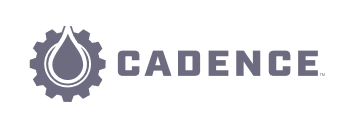

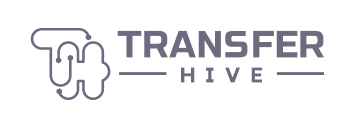















FOR BUSINESS TEAMS
Take your content game to the next level!
Content is everything and Experro empowers business users to create and
manage content faster for all kinds of digital projects.
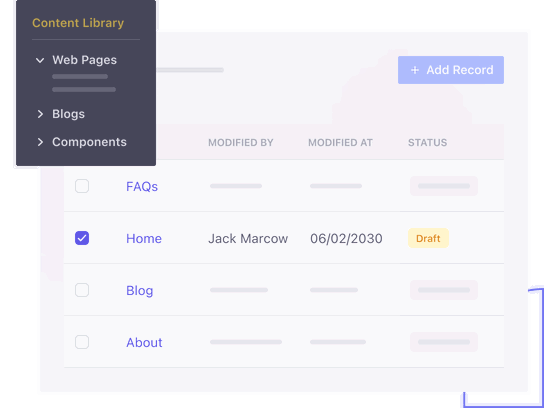
Centralize all content in one place
Content is everywhere, and centralizing all of your content in one platform makes it easier to improve the agility, quality, and reusability of the content that powers your digital experiences.
Whether it's website pages, blogs, short copies, product information, case studies, or dynamic data for apps, Experro allows you to manage and publish all your content in one convenient location.
Whether it's website pages, blogs, short copies, product information, case studies, or dynamic data for apps, Experro allows you to manage and publish all your content in one convenient location.
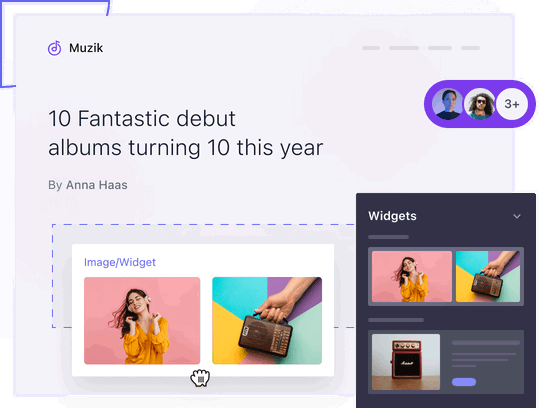
Intuitive and easy editing experience for all users
Transform the way your content team creates and publishes articles - No more rigid panels or floating Word docs.
Content editors can produce better and more consistent content faster by dynamically adding or modifying fields, components, or media to any content page without requiring developer assistance.
Content editors can produce better and more consistent content faster by dynamically adding or modifying fields, components, or media to any content page without requiring developer assistance.
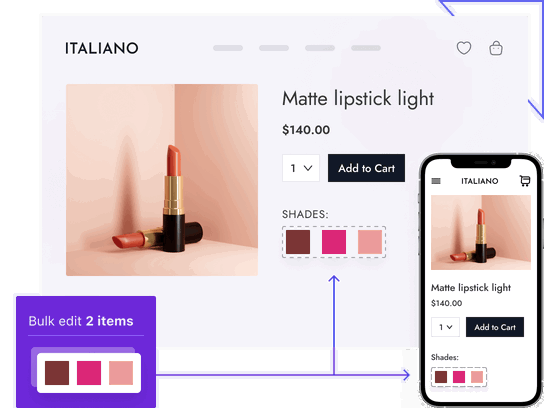
Create once, reuse across all channels
Maximize the value of your content by reusing it across various channels and use cases.
You can create modular content that can be used in different combinations (like Lego(TM) blocks) across digital channels and customer experiences. That means less time reinventing the wheel and more time working on new ideas.
You can create modular content that can be used in different combinations (like Lego(TM) blocks) across digital channels and customer experiences. That means less time reinventing the wheel and more time working on new ideas.
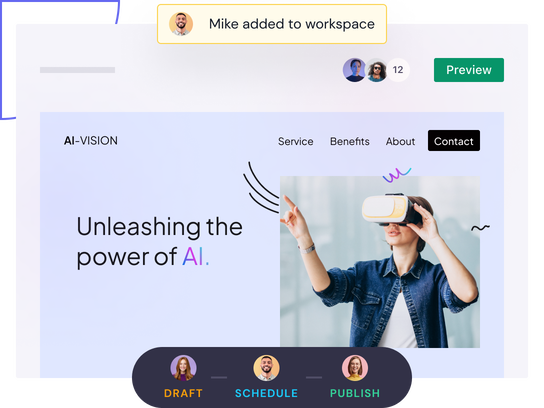
Accelerate and scale content workflows
Streamline the creation, review, and publishing process to improve your content velocity.
Experro’s multiple environments simplify the content creation process at every stage, allowing writers to create and preview their work. At the same time, editors can review and publish or schedule it for later release in line with events and planned releases.
Experro’s multiple environments simplify the content creation process at every stage, allowing writers to create and preview their work. At the same time, editors can review and publish or schedule it for later release in line with events and planned releases.
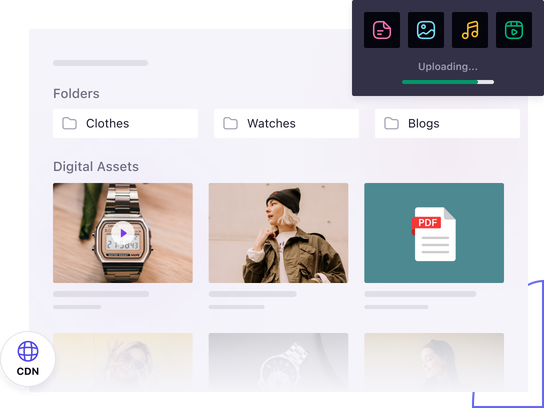
Organize, optimize, and deliver rich media assets
Media such as files, images, and videos are a huge part of content management. Experro’s built-in media manager allows you to upload media files, organize them in a Google-drive-like folder system and enrich them in one place.
Experro optimizes these assets for each device and serves them from its ultra-fast global edge CDN to ensure every digital experience is richer and faster.
Experro optimizes these assets for each device and serves them from its ultra-fast global edge CDN to ensure every digital experience is richer and faster.
We’ll help you get started
FOR ENGINEERING TEAMS
Built to scale and optimized to perform
Designed with the most advanced technologies and architecture, Experro offers a blazing-fast experience for billions of web and mobile users.
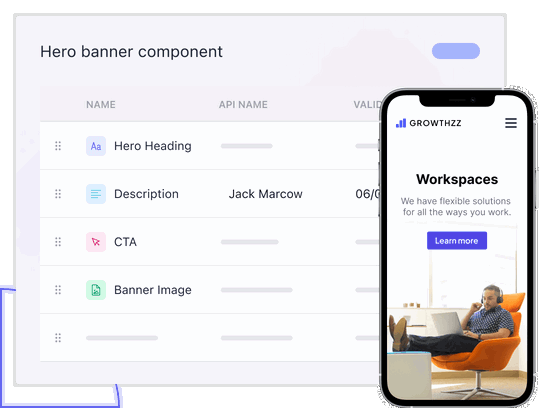
Flexible content model that adapts to your needs
Have complete freedom to design models to store and manage any content using pre-built or custom fields.
Blog posts, landing pages, case studies, social posts... give your business users the freedom to publish content on-demand with an outstanding editing experience.
Blog posts, landing pages, case studies, social posts... give your business users the freedom to publish content on-demand with an outstanding editing experience.
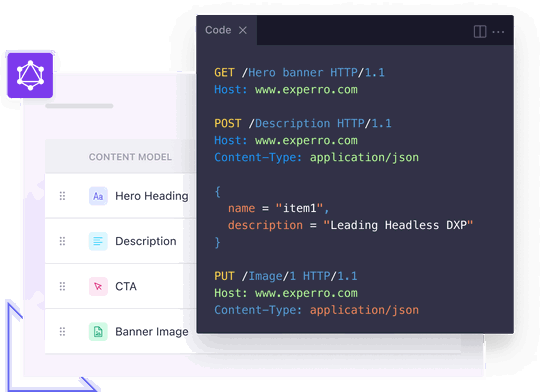
Out-of-the-box Headless APIs
Experro offers out-of-the-box REST and GraphQL APIs that automatically adapt to your content model and can instantly serve your unique content to any frontend apps of your choice. No code or extra work is required.
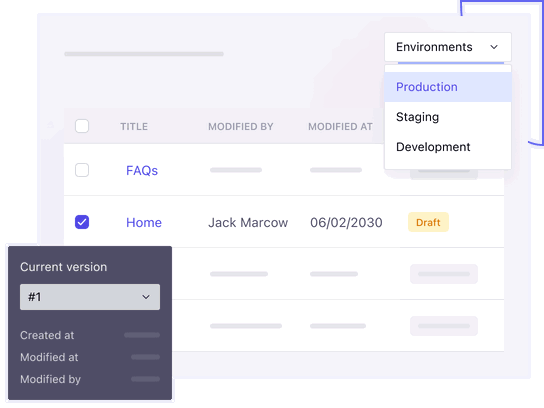
Environments & Release Management
Create faster and publish with confidence. Experro provides multiple environments, including development, staging, and production, to facilitate the creation of robust and enterprise-level release workflows.
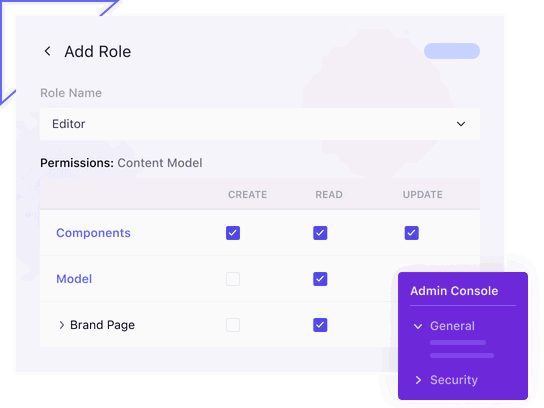
Control access with custom roles and permissions
Experro offers advanced role-based access control with granular permissions at multiple levels, such as fields, models, and workspaces, to ensure that only the right people can create, modify, and publish the appropriate content.
Want to see Experro Headless CMS in action?
Let us show you how Experro can help you transform your website editing experiences.
More Experro features for developers

Internationalization
Create content in more than 150 languages to cater localized experiences to global customers.

SDKs & CLI Tools
Integrate your Experro content inside your web apps and mobile apps with our APIs and SDKs.

Content Versioning
Keep track of content changes with automatic content versioning, rollback, and compare features.

Extensive Documentation
Master our headless CMS platform and use cases with comprehensive documentation.

Authentication & Authorization
Experro offers JWT authentication for all APIs and SSO support for enterprise deployments.

Get started in less than 5 mins
Experro is designed for developers' productivity, and you can get the hang of it in less than 5 mins.
Build your own frontend with preferred frameworks

Turn your content into beautiful web experiences with native Frontend
Experro offers a fully-managed Frontend development platform and tooling to build headless eCommerce stores and blazing-fast websites.
- Server-side rendering
- Drag-and-drop page builder
- Works with existing eCommerce backends

Dedicated Partner
Our dedicated experts work with you and your team at every stage to help you get started and maximize the value.

24x7 In-app Support
Our award-winning customer success team is available right on the Experro app to support and answer any questions

Implementation Help
Our seasoned team assists you throughout the implementation process, from planning and architecture integration to CMS launch.
Headless CMS FAQs
What is Headless CMS Software?
Headless CMS software is a type of content management system (CMS) that provides a way to manage content without being tied to a specific frontend or presentation layer.
Unlike a traditional CMS, where the content management backend and the frontend display are tightly coupled, a headless CMS platform separates the content repository from the presentation, offering greater flexibility among many other benefits.
Our headless CMS guide throws more light on the platform.
How does a headless CMS system work?
A headless CMS system separates the content management backend from the frontend delivery layer of a website or application.
The content is stored and managed in a content repository in the backend, and is delivered to various frontend systems through APIs, CDN, and dynamic SSR technology.
This API-driven headless CMS makes content delivery blazing-fast and smooth, allowing for greater flexibility in terms of how the content is displayed and consumed across multiple channels and devices.
What are the benefits of headless CMS software?
The advantages of headless CMS are numerous. They include:
Flexibility: With a headless CMS platform, you have complete control over how content is presented, making it easier to deliver structured content across multiple channels.
Speed: Being API-driven, a fast headless CMS allows for quicker content delivery and overall performance.
Scalability: A cloud-based headless CMS solution can easily adapt to increased demands, perfect for enterprise-level needs.
Omnichannel: Easy distribution of digital content across web and mobile applications and other digital channels.
Technical Freedom: Developers can use any programming language, including popular frameworks like React-based headless CMS, to interact with the CMS.
Non-Developer Friendly: An intuitive interface makes it easy for content editors and non-technical users to manage content, thus enabling a broader range of people to interact with the system effectively.
Thus, a headless content management system is a powerful tool for both developers and non-developers. Its API-driven architecture and user-friendly interface make it a go-to solution for modern digital content management.
What are some use cases of a headless CMS platform?
Headless CMS platforms can be used in a variety of industries and for a wide range of use cases. Here are a few examples:
eCommerce: Headless CMS software can be used to manage and deliver product information, such as descriptions, pricing, and inventory, to eCommerce platforms. They can also be used to create and deliver personalized content and product recommendations to customers.
Media and Entertainment: A Headless CMS solution can be used to manage and deliver content, such as articles, videos, and images, to media websites and mobile apps. They also offer advanced search and filtering capabilities and support for multiple languages.
Education: API-driven headless CMS platform can be used to manage and deliver educational content, such as online courses and tutorials, to learning management systems and mobile applications.
Travel and Tourism: A headless content management system can be used to manage and deliver information about destinations, accommodations, and travel itineraries to travel websites and mobile applications.
Healthcare: Cloud-based headless CMS solutions can be used to manage and deliver health-related content, such as medical information and patient education materials, to hospital websites and patient portals.
Marketing: SaaS headless CMS platforms can be used to manage and deliver marketing content, such as landing pages, email campaigns, and social media posts, across multiple digital channels and devices.
Government: The headless CMS can be used to manage and deliver government-related content, such as laws, regulations, and public service announcements, to government websites and digital platforms.
Non-Profit: Headless CMS software can be used to manage and deliver content, such as fundraising campaigns and volunteer opportunities, to non-profit websites and mobile apps.
Real Estate: Lightweight headless CMS can be used to manage and deliver information about properties, such as photos, descriptions, and floor plans, to real estate websites and digital assets.
Automotive: Headless CMS platforms can be used to manage and deliver information about vehicles, such as specifications, features, and pricing, to automotive websites and digital experiences.
Banking and Financial Services: A flexible headless CMS platform can manage and deliver financial-related content like investment advice and financial planning.
This content can be distributed to websites and digital channels in the banking and financial services sector.
The best headless CMS platform offers a flexible and scalable way to manage, deliver, and distribute content across multiple channels and devices.
It also provides advanced features like personalization, search and filtering, and integration with other systems.
What are the types of headless content management systems?
Understanding the different types of headless CMS is crucial for selecting the right solution that fits your needs.
Types of headless CMS can be categorized as follows:
Commercial Headless CMS Software
Commercial Headless CMS platforms are proprietary and often offered as headless CMS as a service. These platforms usually come with premium features like technical support, data analytics, and advanced creative asset management capabilities.
They cater mostly to enterprise headless CMS needs, and Experro is one of the leading examples in this category.
Git-based CMS
A Git-based CMS is a type of headless CMS system where content is stored in a Git repository. These are ideal for developers who are accustomed to Git workflows.
Content changes are pushed to the repository, allowing for version control and straightforward deployments. Jekyll and Hugo are often used in these setups.
Hybrid CMS
A Hybrid CMS combines the capabilities of a traditional CMS with headless architecture. It provides a content repository to manage content, while also offering an optional presentation layer to display content.
This flexible headless CMS setup lets you distribute content across multiple channels, be it web and mobile applications or other digital platforms.
Decoupled CMS
A Decoupled CMS is an advanced form of headless CMS. Unlike a purely headless CMS, a decoupled system consists of a head that is separate but connected to the body (backend), allowing content to be pushed to a frontend layer or retrieved via API calls.
It delivers structured content to different platforms, enabling you to reuse content across multiple devices.
Open-Source Headless CMS Software
An Open-Source Headless CMS is a free-to-use, community-driven headless CMS software. These platforms often have the benefit of being highly customizable, offering businesses complete control over how they manage and publish content. Examples include Strapi and Directus.
These are just a few examples; the ecosystem is large and continually evolving. The best headless CMS software for your project will depend on your specific requirements, including the technologies you're using, your team's expertise, and your project's scale and complexity.
What are the features of a headless CMS platform?
A headless CMS, or Content Management System, is a backend system that allows for content storage, management, and organization but does not provide a frontend for displaying the content.
Instead, the content is delivered through APIs and can be integrated into any frontend system. Here are some common features of headless CMS platforms:
Content Management: The ability to create, edit, and manage content in a centralized location. This includes the ability to create different types of content, such as text, images, videos, and more.
Content Scheduling: The ability to keep track of changes made to the content, view previous versions, and revert to earlier versions if needed.
User Management: The ability to control access to the CMS and assign different roles and permissions to users.
APIs for Content Delivery: The ability to deliver content to different frontend systems through APIs. This allows for greater flexibility in terms of how the content is displayed and where it is delivered.
Search and Filtering: The ability to search for and filter content by specific criteria, making it easier to find and manage large amounts of content.
Workflow Management: The ability to manage the process of creating and publishing content, including creating custom workflows and assigning tasks to different users.
Multi-language Support: The ability to manage and display content in multiple languages.
Media Management: The ability to manage and deliver media files, such as images and videos.
Integrations: The ability to integrate with other systems and platforms, such as e-commerce platforms, CRMs, and analytics tools.
Scalability: The ability to handle a large amount of content and handle traffic spikes without performance degradation.
Security: The ability to secure the CMS and the content it stores and protect against unauthorized access and data breaches.
Analytics and Reporting: The ability to track the performance of the content and measure its impact.
Customizable: The ability to customize the CMS to meet the specific needs of the organization or project.
Flexibility: The ability to create and deliver content across different devices and channels, including web, mobile, and emerging technologies.
Cloud-based or On-premise: The ability to host the CMS on cloud servers or on-premise servers, depending on the organization's preference and requirements.
Support for Different Content Types: The ability to handle different types of content such as text, images, videos, audio, and more.
Improved Collaboration: The ability for multiple users to work on the same content at the same time, from different locations, with different roles and permissions.
Improved Content Distribution: The ability to distribute content to multiple channels and platforms, including social media, email, and mobile apps.
Overall, a headless CMS offers a flexible, scalable, and secure way to manage, deliver, and distribute content across multiple channels and devices.
Who can use Headless CMS Software?
The application of headless CMS software is broad, making it a versatile tool for various individuals and organizations.
Whether you are managing a multi-platform digital campaign or simply trying to streamline your content management, there's likely a headless CMS software that suits your requirements. Here's who can benefit from using headless CMS:
Digital Marketers: With a cloud based headless CMS solution, digital marketers gain a lot of flexibility in displaying content across multiple digital channels. This is invaluable for campaigns that need to be agile and adapt to different platforms quickly.
eCommerce Retailers: Those operating online stores would find eCommerce headless CMS options particularly beneficial. These systems allow for seamless content management and product display across various platforms, from web to mobile applications.
Content Creators: Independent bloggers, journalists, and other creators can benefit from a lightweight headless CMS. This allows them to focus on content creation while the system takes care of how the content is presented and distributed.
Mobile App Developers: Since headless CMS solutions are decoupled from the presentation layer, they are an excellent choice for mobile app developers who need to manage content across multiple platforms. A headless CMS with a visual editor can offer an intuitive interface for managing this content.
Large-scale Enterprises: Large organizations often have complex needs that are well-served by a headless CMS meant for such enterprises. This type of CMS offers robust scalability and can integrate easily with existing enterprise solutions, making it a preferred headless CMS for enterprise needs.
Headless CMS platform is a versatile tool that can serve a wide range of users—from digital marketers to large enterprises. Its ability to manage and distribute content across various digital platforms makes it an invaluable resource for anyone involved in digital content management.
What are the Best Headless CMS Software?
Only a few platforms in the market have made it to the best headless CMS software list. As follows:
1. Experro: A leading headless CMS known for its advanced architecture and seamless integration capabilities. Experro offers impressive speed, robust security features, and an intuitive user interface, catering to both developers and content creators with its comprehensive APIs and extensive documentation.
2. Contentful: A well-established headless CMS platform that provides a flexible content modeling system and extensive developer tools, enabling easy content distribution across various digital channels.
3. Strapi: An open-source headless CMS that gives developers the freedom to customize and offers a user-friendly content creation interface.
4. Sanity.io: A platform distinguished by its real-time collaboration features, offering a highly customizable content studio and tailorable workflows for diverse team needs.
5. Kentico Kontent: A cloud-based CMS platform that provides features for content modeling, collaboration, and multi-channel content delivery, allowing businesses to create and manage their digital content efficiently.
6. Storyblok: Blends traditional and headless CMS with a unique visual editor, giving businesses the tools to create content that's easily integrated into various platforms and systems.
7. Butter CMS: Designed to integrate smoothly across various frameworks and languages, offering a straightforward API and a user-friendly dashboard for content managers.
8. Cosmic: A cloud-native headless CMS platform, emphasizing flexibility with features such as webhooks, localization, and a modular content structure.
We are proud to share the news that Experro headless CMS has an edge over the industry competitors in terms of an amazing customer service, feature-rich headless CMS, first-class user experience, and much more. Book a demo to know it all.
Why is Experro the best headless CMS software?
Experro is the top headless CMS for various reasons:
- Outstanding digital experience
- Smooth integration capabilities with BigCommerce & Shopify
- Robustly secured platform
- Performs just fine despite high volume traffic
- Justified budget as per the feature provisions
Can I create a custom headless CMS?
Yes, it is possible to create a custom headless CMS by building your own backend and APIs to deliver content to the frontend. This is typically more complex and time-consuming than using an existing headless CMS platform, but it allows for more flexibility and customization.
How does Experro differ from traditional CMS platforms?
Experro sets itself apart through its intuitive interface, fast content delivery, and robust scalability. It also offers advanced features like personalization and multi-language support.
Can I integrate Experro with my existing tools and systems?
Yes, Experro offers a range of APIs and integration capabilities, allowing you to connect it seamlessly with other tools and systems you're already using.
